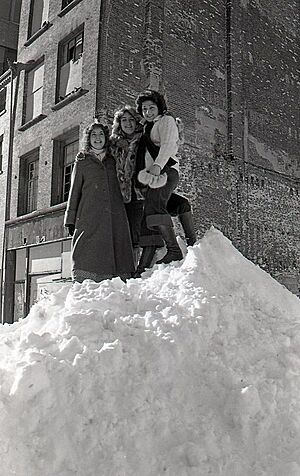Snowdrift facts for kids
A snowdrift is a pile of snow that the wind has shaped into a mound during a snowstorm. Imagine a small hill made entirely of snow! These drifts look a lot like sand dunes you might see in a desert. They form in a similar way: wind picks up light snow and then drops it when the wind slows down, often against something solid like a building or a fence. Snowdrifts can cause big problems, especially for travel.
Contents
What is a Snowdrift?
A snowdrift is essentially a natural sculpture made by wind and snow. When a snowstorm brings fresh, light snow, strong winds can pick up these tiny snow crystals. As the wind carries the snow, it looks for places to slow down. When the wind hits an obstacle, like a wall, a car, or even a small bump in the ground, it loses speed. This causes the snow it was carrying to fall and pile up.
How Snowdrifts Form
Wind is the main artist behind a snowdrift. It gathers loose snow from open areas. Then, it pushes and carries this snow along. Think of it like a broom sweeping dust. The wind keeps moving the snow until it meets something that blocks its path.
Obstacles and Deposits
When the wind carrying snow hits an object, like a building or a snow fence, it creates an area where the air pressure changes. On the side facing the wind (the windward side), snow tends to pile up and slope gently. On the side sheltered from the wind (the leeward side), the snow also builds up, but often in a different shape. The area right next to the object on the leeward side might be a bit lower, but the overall drift can be quite large and flat. This is why you often see huge snow piles behind fences or cars after a big storm.
Snowdrifts and Transportation
Snowdrifts can be a much bigger problem for travel than just the amount of snow that falls. They can block roads, driveways, and even entire railway lines. For example, during the Great Blizzard of 1978 in the United States, massive snowdrifts made many roads impassable.
Why Roads are Affected
Roads are often prime spots for snowdrifts. The raised edges of a road or the ditches alongside it can act as perfect obstacles. These features disrupt the wind flow. When the wind carrying snow hits these disruptions, it drops its snowy cargo right onto the road. This can quickly create deep piles of snow that cars cannot drive through.
Using Snow Fences
To help prevent snowdrifts from blocking roads, people use special structures called snow fences. These fences are placed on the side of the road where the wind usually comes from. Their job is to create a snowdrift before the snow reaches the road. The fence slows down the wind, causing the snow to pile up harmlessly on the field side, keeping the road clear.
Images for kids
-
A snowdrift on the Long Mynd in Shropshire, England.
-
A tall snowdrift blocking a car in Kenosha, Wisconsin.
Learn More
- Blizzard
- Lake-effect snow
- Big Drift
- Snow removal




